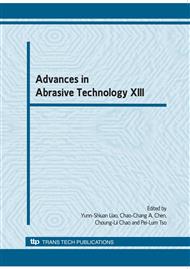p.615
p.621
p.627
p.633
p.639
p.645
p.653
p.658
p.667
Investigation on Material Property of Electrically Conductive Polycrystalline Composite Diamond (EC-PCD)
Abstract:
Electrically conductive polycrystalline composite diamond (EC-PCD) material, which consists of electrically conductive diamond grits, has recently been developed for the purpose of providing the material with both excellent tool property and machinability. This paper deals with the material property and the wear characteristics of EC-PCD. The result shows that the EC-PCD is superior in heat resistance compared with the conventional PCD. And the EC-PCD shows low frictional wear at high temperature in sliding test against stainless steel disk. Furthermore, in a cutting test of aluminum alloy, the EC-PCD cutting tool shows the same wear characteristics as the conventional PCD tool.
Info:
Periodical:
Pages:
639-644
Citation:
Online since:
August 2010
Authors:
Price:
Сopyright:
© 2010 Trans Tech Publications Ltd. All Rights Reserved
Share:
Citation:


